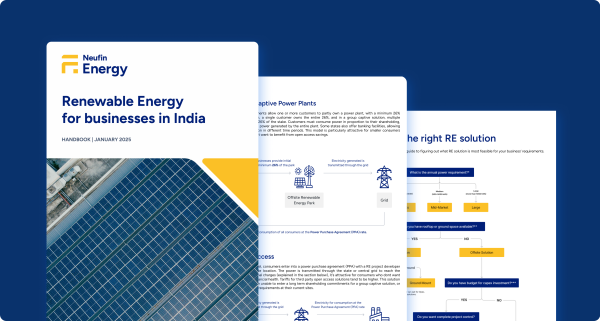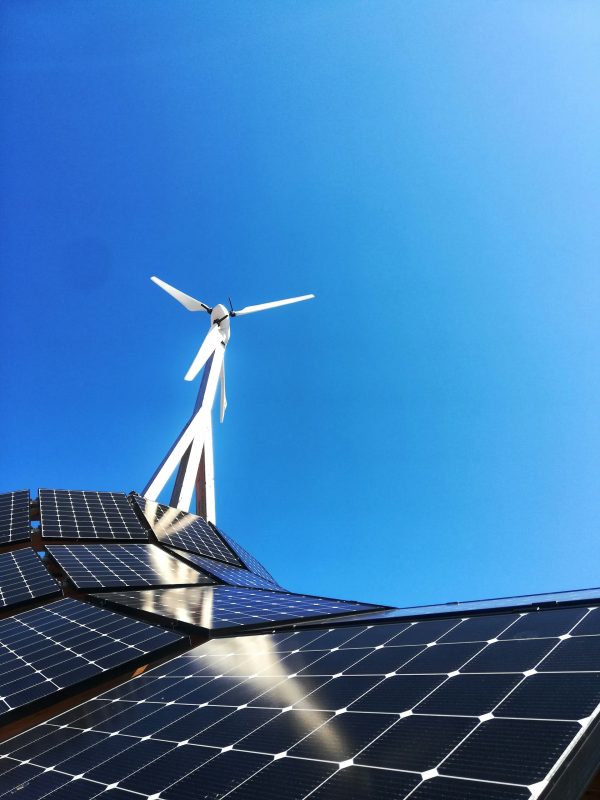As businesses work toward reducing their carbon footprints and energy costs, they face a pivotal decision: should they opt for an onsite renewable energy solution, like a rooftop solar installation, or consider an offsite option, such as grid-connected Open Access solar? Each path has its own advantages and trade-offs, making the choice dependent on factors like space, energy requirements, and long-term goals. This article will clarify the differences, benefits, and key considerations for both onsite and offsite solutions, helping businesses make an informed choice.
Understanding onsite solar solutions
Onsite solar installations are renewable energy systems deployed directly on your business premises. These systems offer immediate and visible benefits while giving you direct control over your energy generation. When installed properly, they can significantly reduce your dependence on grid electricity while providing a tangible demonstration of your commitment to sustainability.
Rooftop solar: the most common choice
Rooftop solar installations have become increasingly popular among Indian businesses, particularly those with substantial unshaded roof areas. These systems typically range from 10 kW to 1 MW, depending on available space and energy requirements. One of the primary advantages of rooftop solar is its ability to provide power right at the point of consumption, eliminating transmission losses that occur with grid electricity.
The system’s effectiveness is further enhanced by net metering policies, which allow businesses to export excess power to the grid during peak generation hours and import it when needed. This arrangement effectively turns the grid into a virtual battery, maximising the value of your solar installation.
Ground-mounted systems: when space permits
For businesses with available land, ground-mounted solar systems offer an excellent alternative to rooftop installations. These systems provide greater flexibility in terms of design and orientation, often resulting in higher efficiency compared to rooftop systems. They’re particularly well-suited for manufacturing units with high power requirements and businesses looking to scale their renewable energy capacity over time.
Ground-mounted systems also offer practical advantages in terms of maintenance and monitoring. Unlike rooftop installations, these systems are easily accessible for cleaning and repairs, which can lead to better long-term performance and reliability.
Exploring offsite solar solutions
When physical space is limited or energy requirements exceed onsite generation capacity, offsite solar solutions provide a viable alternative. These arrangements allow businesses to source renewable energy through the grid, offering flexibility and scalability without the constraints of physical installation.
Open Access: the foundation of offsite solar
Open Access is a mechanism that allows consumers with electricity loads above 100 kW to purchase power directly from power generators or traders through the existing transmission and distribution network. This framework, established under the Electricity Act 2003, has been further strengthened by the Green Open Access Rules 2022, making renewable energy more accessible to businesses.
The beauty of Open Access lies in its flexibility—businesses can source green power without investing in physical infrastructure on their premises. Instead, they use the existing grid infrastructure to wheel power from distant solar plants to their facilities. This system has opened up several business models for renewable energy procurement, each suited to different business needs. The cost of Open Access power includes several components beyond just the basic energy charges:
- Transmission and wheeling charges for using the grid infrastructure
- Cross-subsidy surcharges (which can be waived under certain models)
- Additional surcharges and taxes that vary by state
- Banking charges for storing excess generation
Third-party Open Access
The simplest form of open access involves directly purchasing power from an independent power producer (IPP). This model requires:
- No equity investment from the business
- Only a power purchase agreement with the generator
- Payment of all applicable open access charges While this offers maximum flexibility, the inclusion of all surcharges can sometimes make it less economically attractive than other models.
Captive power plants
In a captive arrangement, a business owns 100% of a solar plant located elsewhere and wheels the power to its facility. This model offers:
- Complete control over the power plant
- Exemption from cross-subsidy surcharges
- Better economics due to reduced charges
- Higher initial investment requirement
Group captive: the popular middle ground
The group captive model has emerged as a particularly attractive option for Indian businesses, balancing investment requirements with economic benefits. Under this arrangement:
- Multiple businesses collectively invest in a solar plant
- Each consumer must maintain a minimum 26% equity stake
- Owners must consume 51% of the total generation
- Cross-subsidy surcharges are waived, similar to captive plants
This structure offers significant advantages for businesses with monthly electricity bills exceeding ₹3 lakhs. The shared investment reduces individual capital requirements while maintaining the benefits of captive consumption. The model is particularly effective in states with supportive banking policies, where excess generation can be stored and used during non-solar hours.
Making the right choice: a decision framework
Understanding your business’s specific characteristics and goals is crucial for choosing the right solar solution. Here’s a comprehensive framework to guide your decision:
Onsite solutions are best suited for businesses with:
Energy consumption patterns
- Primary operations during daylight hours (9 AM – 5 PM)
- Monthly electricity bills between ₹50,000 to ₹3 lakhs
- Stable, predictable energy consumption patterns
- Peak demand coinciding with peak solar generation hours
Infrastructure considerations
- At least 10,000 sq ft of shadow-free roof space per 100 kW requirement
- Roof structure less than 15 years old and structurally sound
- Ownership status and plans to stay for 10+ years
- Local grid infrastructure supporting net metering
Business goals
- Visible demonstration of sustainability commitment
- Green building certification requirements
- Direct control over energy infrastructure
- Protection against rising electricity costs
Offsite solutions are ideal for businesses with:
Energy consumption patterns
- 24/7 operations or significant night-time consumption
- Monthly electricity bills exceeding ₹3 lakhs
- Varying seasonal demand patterns
- Multiple locations requiring power supply
Infrastructure considerations
- Limited or structurally unsuitable roof space
- Leased premises or rented facilities
- Planned facility expansion or relocation in near future
- Multiple facilities across different locations
Business goals
- Renewable energy scaling across multiple locations
- Large-scale renewable energy targets
- Flexibility in energy procurement strategies
- Competitive energy rates without asset management responsibilities
Industry-specific considerations
Different industries often have distinct needs that influence their optimal solar strategy. Manufacturing units, for example, might benefit from a combination of ground-mounted onsite systems and group captive arrangements to meet their high power requirements. Commercial offices, with their predominantly daytime operations, often find rooftop solar particularly effective, especially when combined with green building initiatives.
Retail chains face unique challenges, particularly when operating across multiple locations. For owned properties, distributed onsite systems can provide direct benefits while enhancing brand value through visible sustainability initiatives. For leased spaces, offsite solutions offer a way to achieve renewable energy goals without physical installations.
Conclusion
The renewable energy landscape in India offers numerous pathways for businesses to achieve their sustainability goals while managing energy costs. Whether through onsite installations that provide direct control and visible sustainability credentials, or offsite solutions that offer flexibility and scalability, the key is to align your choice with your business’s unique circumstances and objectives.
For many businesses, the optimal approach might be a hybrid solution—combining onsite installations where feasible with offsite procurement to meet remaining requirements. As regulations and incentives continue to evolve, working with experienced solar developers and consultants can help navigate these changes while ensuring your chosen solution delivers maximum value for your business.
Neufin can help you navigate your business’s renewable energy procurement journey by breaking down the complexities of regulations, incentives, and technical requirements to make an informed decision that aligns with your overall goals. As a first step, learn how much can your business save on electricity costs by trying out the Neufin Energy Analyser.



